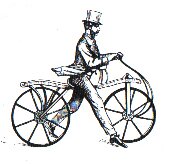 Cycling has a tremendous history unknown to many who ride today's modern "vehicle".
Cycling has a tremendous history unknown to many who ride today's modern "vehicle".
Cartwheels with spokes are reported to have been used in Mesopotamia over 4,000 years ago. It is also said that the Chinese used wheels with spokes over 6,000 years ago. No one at that time however latched onto what now seems to be the obvious use for these items, ie. one behind the other and to use this as a mode of transport.
The history of cycling has had an immense influence on the technologies, industries and sports events of today. The story of the bicycle starts in 1817 when Baron von Drais of Baden invented a 'running machine' to help him move more quickly around his forests.
The 'Draisienne', seen above, as it was known, briefly became a fashionable toy for the upper classes in Paris and London, and was much copied by other manufacturers. In subsequent years, many craftsmen designed 2, 3 or 4-wheeled vehicles powered by human energy - otherwise known as 'velocipedes'.
A Scottish blacksmith, Kirkpatrick Macmillan, earned himself a five shilling fine in around 1840 for knocking over a child on a ride from Dumfries to Glasgow. But the bicycle didn't experience its first proper breakthrough until the French mechanic Pierre Michaux attached cranks to the front wheel of a Draisienne in the 1860s.
This led to a craze for cycling on both sides of the Atlantic. With the outbreak of war between France and Prussia, James Starley of the Coventry Machinists Company took up the challenge of refining the French 'boneshakers'. He increased the front wheel diameter to allow greater speed, which led to the familiar 'penny-farthing' design.
At the same time, Starley and others improved the technology of gears, brakes and wheels, both on bicycles and less dangerous alternatives such as tricycles. In 1885, John Kemp Starley (James' nephew) invented the 'Rover' bicycle, which overcame the dangers of a large front wheel by attaching gears and cranks to the rear wheel instead.
In 1888, John Boyd Dunlop invented pneumatic tyres - competitions then proved that a 'safety' bicycle with pneumatic tyres could easily match the daredevil speeds of the penny-farthing. This established the standard design that has survived to the present day.
Since then, bicycles have had a huge impact on society. JK Starley went on to form the Rover car company, and many other transport pioneers - such as Henry Ford and the Wright Brothers - also began as cycle mechanics.
Cycling opened up new horizons for people in the nineteenth century by allowing them to travel beyond their home community - this was especially important for women, and can be seen now also in the developing world. Finally, competitive cycling provided one of the earliest forms of mass spectator sport in modern times.
Our thanks go to Dr Paul Rosen for the above contribution. When he's not writing informative sections for us he can be found at the Science & Technology Studies Unit, University of York, e-mail address
Dr Paul Rosen is also the author of Framing Production: Technology, Culture and Change in the British Bicycle Industry (MIT Press, 2002). Paul has also written the section covering Cycle Commuting.